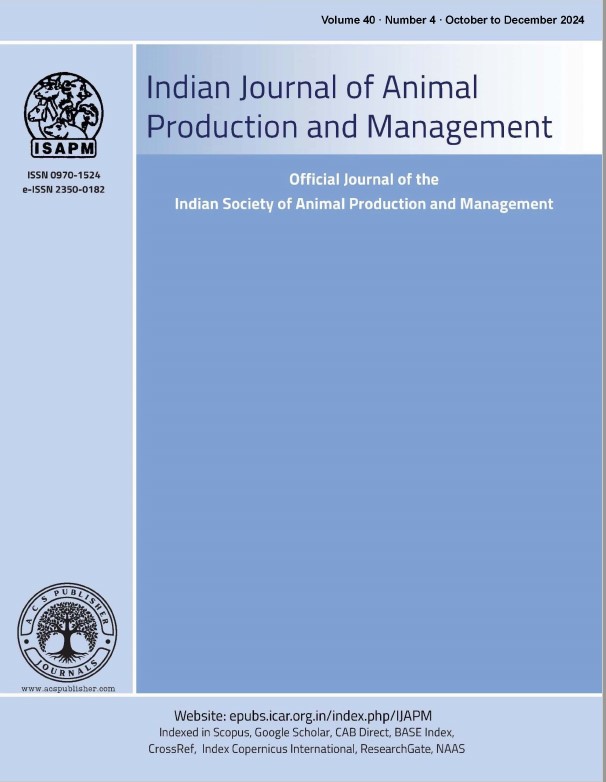A Study on the Effect of Housing on Parasitic Load of Nellore Lambs
DOI:
https://doi.org/10.48165/ijapm.2024.40.2.8Keywords:
Nellore Jodipi lambs, Housing, Parasitic load, EPGAbstract
A study was carried out to find out the effect of housing on Parasitic load of Nellore Jodipi lambs under tropical environmental conditions. Thirty weaned Nellore ram lambs of 3-4 months age were selected based on body weight and randomly divided into three groups of ten animals each. The parasitic load i.e., Egg per gram (EPG) was determined regularly at every month during entire study period. The faecal egg count was performed by a Mc Master technique. With regard to parasitic load, the prevalence of parasites and eggs per gram (EPG) count were significantly (P<0.05) lower in slatted floor housing system (11.3±3.14) than that of morum floor housing systems (25.6±3.98 and 25.5±3.80). It was concluded that the housing system of elevated slatted flooring with galvalume roofing proved to be effective in controlling reinfestation of parasites and maintain hygiene environment for better performance of Nellore ram lambs.
References
Al Haidary A A, Aljumaah R S, Alshaikh M N, Abdoun KA, Samara E A, Okab A B and Alfuraiji M M 2012. Thermoregulatory and physiological responses of Najdi sheep exposed to environmental heat load prevailing in Saudi Arabia. Pakistan Veterinary Journal 32(4): 515- 519.
Bhatia B B, Pathak, K M L and Juyal, P D 2010. Text book of veterinary parasitology. 3rdEdition, Kalayani Publishers, New Delhi.
Blessy P G, Godlin P and Kumaravelu N 2017.
Faecal Egg Count, Floor Microbial Load And Ammonia Emission Level In Stall Fed Goat Sheds. International Journal of Innovative Research and Advanced Studies 4(7): 36-39.
Iyad Badran, Ruba Abuamsha, Rateb Aref, Wael Alqisi & Jaber Alumor 2012. Prevalence and Diversity of Gastrointestinal Parasites in small Ruminants under Two Different Rearing Systems in Jenin District of Palestine. An - Najah Univ. J. Res. (N. Sc.) vol. 26.
Koinari M, Karl S, Ryan U and Lymbery A J 2012. Infection levels of gastrointestinal parasites in sheep and goats in Papua New Guinea. Journal of Helminthology.
Rahman Atikur Md, Sharmin Shahid Labony, Anita Rani Dey and Mohammad Zahangir Alam 2017. An epidemiological investigation of gastrointestinal parasites of small ruminants in Tangail, Bangladesh. Journal of Bangladesh Agricultural University 15(2): 255–259.
Ramachandran, S P Singh, M K Tripathi, Souvik Paul, Saket Bhusan and S K Jindal 2016. Intake, growth performance and worm load in goat kids maintained on conventional soiled or raised wooden slatted floor. Indian Journal of Animal Sciences 87(3): 356-360.
Sultan Khaled, Elmonir Walid, Hegazy Yamen 2016.Gastrointestinal parasites of sheep in Kafrelsheikh governorate, Egypt: Prevalence, control and public health implications. Beni- suef university journal of basic and applied sciences 5:79–84.

